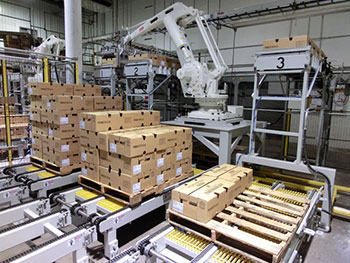
Unforeseen Benefits of Adding Robot Labor to the Workplace
Geoff Schreiber | 17 December 2014
Robotic automation is becoming more commonplace in the manufacturing realm, with general industry and automotive parts suppliers leading the way. Modernizing factories throughout the Americas, the expected benefits have contributed to an increased number of robot installations, but the unexpected benefits have rapidly accelerated the pace of those installs.
When implementing an industrial robot, be it a traditional, collaborative, or mobile robot, manufacturers expect several common benefits. From reduced operating costs related to energy and waste to improved quality, consistency and production rates, robots help companies to be more competitive and more flexible while improving employee health and safety. After implementation while monitoring the ROI though, several unexpected benefits have been recognized, helping realize that return in even six to twelve months.
Maintenance Benefits
For example, while adding what may seem a complex automation system, many facilities have realized a decrease in maintenance costs. Due to the higher yield and throughput most robotic systems achieve, upstream production lines have on occasion been able to shut down more frequently to allow for preventative maintenance tasks, avoiding expensive downtime from unplanned maintenance. Additionally, where additional staffed equipment may have been added previously to widen the production bandwidth, the improved efficiency with a robot may allow that floor space to be regained for other production needs.
Collaboration Benefits
In situations specifically involving a collaborative robot, where a worker may be in close proximity to a robotic system, worker’s idle time has been reduced by amounts up to 85%. Collaborative robots are commonly deployed for lightweight, repetitive tasks such as part retrieval or simply assisting in holding a part for an operator to apply fasteners. In these installations, the robots are much more like common labor – with the ideas for their use commonly coming from the workers they aid.
Employee Turnover Benefits
Another one of the larger unexpected benefits has been a reduction in employee turnover. Initially, employees tend to be concerned for their jobs when robotic labor is introduced to their workplace. However, based on the implementation, the investment in the new technology also proves to be an investment in the employees.
In most cases, the robots are aiding in tasks that are repetitive and physically demanding. The existing workforce knows the process, knows what the quality and production requirements are, and can usually be trained to then monitor and operate the robot cell. In turn, the employees have reduced physical fatigue, mental fatigue, and accidents. For example, in the case of mobile robots providing product and pallet handling in warehouses and distribution centers, employees were previously responsible for knowing product storage locations and maintaining rates with colleagues to keep throughput at a maximum, sometimes trying to go too fast or becoming tired, causing accidents.
With the mobile robots, employees can focus on quality checks and specialty products or shipments that wouldn’t be handled by the robot, while staying safely out of the hazardous area of high-traffic storage locations.
Job Creation Benefits
Finally, in many part production facilities, robots have added capacity and even increased the number of jobs. Not only from more technical workers able to modify robot programs and paths, but production and shift managers as well. Skilled workers still tend to be more productive for short part runs with high changeover rates during day shift production, but with the ability for robots to be setup for hours of unmanned production, additional shifts can be added, increasing overall capacity.
Day shift operates as normal--focused on short part runs or more complex parts that are not easy for a quick robot setup--then sets up production to be run unattended by the robot during night shift. A shortened third shift can then complete robot production and clear the work cell for day shift. In summary, the cost of robotic automation has been dropping sharply over the past 10 years, making them more financially affordable with greater long-term savings, plus a host of benefits that may not have even been previously considered.
With the newest robots available on the market, even small- to medium-size enterprises can improve productivity, efficiency, and even employee health, safety, and motivation while still achieving a payback period of six to 18 months. Be sure to contact your Bastian Solutions representative to discuss any potential installations you or your company may be considering. Even if there is still a need to validate the solution for payback or throughput reasons, our consulting group can be involved to help meet your objectives and even offer alternatives based on their review.
Geoff Schreiber is the Engineering Manager for Bastian Solutions robotics division in Saint Louis, MO. His role includes leading the engineering efforts of the mechanical, electrical, and automation disciplines for standard and custom projects as well as coordinating the research and development of new robotic technologies such as goods-to-robot bin picking for fulfilment and replenishment operations. A graduate of Southern Illinois University Edwardsville, Geoff has over 20 years’ experience in software and PLC development in addition to technical design direction for mechanical and electrical products, parts, and components for equipment and machinery.
Comments
No comments have been posted to this Blog Post
Leave a Reply
Your email address will not be published.
Comment
Thank you for your comment.